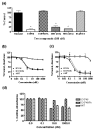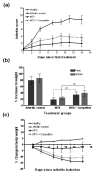Treatment of experimental adjuvant arthritis with a novel folate receptor-targeted folic acid-aminopterin conjugate
- PMID: 21463515
- PMCID: PMC3132048
- DOI: 10.1186/ar3304
Treatment of experimental adjuvant arthritis with a novel folate receptor-targeted folic acid-aminopterin conjugate
Abstract
Introduction: Folate receptor (FR)-expressing macrophages have been shown to accumulate at sites of inflammation, where they promote development of inflammatory symptoms. To target such a macrophage population, we designed and evaluated the biologic activity of EC0746, a novel folic acid conjugate of the highly potent antifolate, aminopterin.
Methods: Using a FR-positive subclone of murine macrophage-derived RAW264.7 cells and rat thioglycollate-elicited macrophages, we studied the effect of EC0746 on dihydrofolate reductase activity, cell proliferation, and cellular response towards bacterial lipopolysaccharide as well as IFNγ activation. The EC0746 anti-inflammatory activity, pharmacokinetics, and toxicity were also evaluated in normal rats or in rats with adjuvant-induced arthritis; that is, a FR-positive macrophage model that closely resembles rheumatoid arthritis in humans.
Results: EC0746 suppresses the proliferation of RAW264.7 cells and prevents the ability of nonproliferating rat macrophages to respond to inflammatory stimuli. In the macrophage-rich rat arthritis model, brief treatment with subcutaneously administered EC0746 is shown to mediate an FR-specific anti-inflammatory response that is more potent than either orally administered methotrexate or subcutaneously delivered etanercept. More importantly, EC0746 therapy is also shown to be ~40-fold less toxic than unmodified aminopterin, with fewer bone marrow and gastrointestinal problems.
Conclusions: EC0746 is the first high FR-binding dihydrofolate reductase inhibitor that demonstrates FR-specific anti-inflammatory activities both in vitro and in vivo. Our data reveal that a relatively toxic anti-inflammatory drug, such as aminopterin, can be targeted with folic acid to inflammatory macrophages and thereby relieve inflammatory symptoms with greatly reduced toxicity.
Figures






Comment in
-
A new weapon against an old target.Arthritis Res Ther. 2011 Aug 12;13(4):122. doi: 10.1186/ar3392. Arthritis Res Ther. 2011. PMID: 21861856 Free PMC article.
Similar articles
-
A new weapon against an old target.Arthritis Res Ther. 2011 Aug 12;13(4):122. doi: 10.1186/ar3392. Arthritis Res Ther. 2011. PMID: 21861856 Free PMC article.
-
Folate receptor-targeted aminopterin therapy is highly effective and specific in experimental models of autoimmune uveitis and autoimmune encephalomyelitis.Clin Immunol. 2014 Jan;150(1):64-77. doi: 10.1016/j.clim.2013.10.010. Epub 2013 Oct 25. Clin Immunol. 2014. PMID: 24333534
-
Antiinflammatory Activity of a Novel Folic Acid Targeted Conjugate of the mTOR Inhibitor Everolimus.Mol Med. 2015 Jul 8;21(1):584-96. doi: 10.2119/molmed.2015.00040. Mol Med. 2015. PMID: 26181632 Free PMC article.
-
Synthesis of analogues of folic acid, aminopterin and methotrexate as antitumour agents.Prog Med Chem. 1988;25:85-231. doi: 10.1016/s0079-6468(08)70278-9. Prog Med Chem. 1988. PMID: 3076971 Review. No abstract available.
-
Cancer research: from folate antagonism to molecular targets.Best Pract Res Clin Haematol. 2009 Dec;22(4):577-82. doi: 10.1016/j.beha.2009.09.004. Best Pract Res Clin Haematol. 2009. PMID: 19959110 Review.
Cited by
-
Response to 'Ramipril attenuates lipid peroxidation and cardiac fibrosis in an experimental model of rheumatoid arthritis' - authors' reply.Arthritis Res Ther. 2013 Apr 3;15(2):406. doi: 10.1186/ar4196. Arthritis Res Ther. 2013. PMID: 23566352 Free PMC article. No abstract available.
-
Prospects in folate receptor-targeted radionuclide therapy.Front Oncol. 2013 Sep 24;3:249. doi: 10.3389/fonc.2013.00249. Front Oncol. 2013. PMID: 24069581 Free PMC article. Review.
-
Comparison of nanoparticle penetration into solid tumors and sites of inflammation: studies using targeted and nontargeted liposomes.Nanomedicine (Lond). 2015 May;10(9):1439-49. doi: 10.2217/nnm.14.237. Nanomedicine (Lond). 2015. PMID: 25996118 Free PMC article.
-
The folate receptor β as a macrophage-mediated imaging and therapeutic target in rheumatoid arthritis.Drug Deliv Transl Res. 2019 Feb;9(1):366-378. doi: 10.1007/s13346-018-0589-2. Drug Deliv Transl Res. 2019. PMID: 30280318 Free PMC article. Review.
-
Evaluation of the reducing potential of PSMA-containing endosomes by FRET imaging.Cancer Drug Resist. 2021 Mar 19;4(1):223-232. doi: 10.20517/cdr.2020.84. eCollection 2021. Cancer Drug Resist. 2021. PMID: 35582012 Free PMC article.
References
-
- Haringman JJ, Gerlag DM, Zwinderman AH, Smeets TJ, Kraan MC, Baeten D, McInnes IB, Bresnihan B, Tak PP. Synovial tissue macrophages: a sensitive biomarker for response to treatment in patients with rheumatoid arthritis. Ann Rheum Dis. 2005;64:834–838. doi: 10.1136/ard.2004.029751. - DOI - PMC - PubMed
MeSH terms
Substances
LinkOut - more resources
Full Text Sources
Other Literature Sources
Medical

